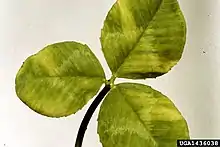| Peanut mottle virus | |
|---|---|
 | |
| Symptoms of peanut mottle virus in a clover leaf (Trifolium spp. L.) | |
| Virus classification | |
| (unranked): | Virus |
| Realm: | Riboviria |
| Kingdom: | Orthornavirae |
| Phylum: | Pisuviricota |
| Class: | Stelpaviricetes |
| Order: | Patatavirales |
| Family: | Potyviridae |
| Genus: | Potyvirus |
| Species: | Peanut mottle virus |
| Synonyms | |
|
Peanut green mosaic virus | |
Peanut mottle virus (PeMoV) is a pathogenic plant virus of the family Potyviridae. As with other members of this virus family, PeMoV is a flexuous filamentous virus with particles 740–750 nm long. It is transmitted by several species of aphids and by mechanical inoculation. It was first given its name in 1965 when it was isolated from peanuts (Arachis hypogaea) in Georgia, United States. The virus was found to be seed transmitted in its host.[1]
Host species
Besides peanuts, the virus is known to infect soybeans (Glycine max), French beans (Phaseolus vulgaris), peas (Pisum sativum), and various weed species of Cassia. Since 1964 it has been identified in East Africa and north-east Australia (in bean) and possible Venezuela, Japan, Malaysia and Bulgaria.[2] Given the fact that PeMoV is seed transmissible in peanuts, the virus could occur anywhere peanuts are grown. In the United States, for example, a survey done in 1975 found the virus in all states where peanuts were grown.[3]
Symptoms
The symptoms of the virus in peanuts appear as irregular dark islands on young leaves. The symptoms are not as clear on older leaves[4][5] and thus can be easily missed even when the virus is in epidemic proportions in the field.
In infected plant cells, the virus makes characteristic potyvirus cylindrical inclusions.[6] that are visible in the light microscope with proper staining.[7]
Disease control
A study of the spread of the virus in Georgia showed that the virus moved from infected peanut plants to nearby soybean fields and was only present in soybeans in areas where peanuts were also grown.[8] Thus, the recommended approach to control the virus in peanuts and other susceptible hosts such as soybeans is the planting of PeMoV-free seed.
PeMoV was reported for the first time in 2007 to infect Rhizoma peanuts (A. glabrata) in Georgia.[9] The plant is propagated by cuttings and is a perennial crop. To avoid spread, growers of the perennial plant have to maintain virus free stock and destroy infected fields. If the virus spreads in perennial peanuts in the Southern United States, the plant has the potential to become a reservoir of the virus and increase its spread to field peanut and soybean via aphid transmission. ( See Peanut stunt virus for a similar situation)
References
- ↑ Kuhn, C.W. (1965) Symptomalogy, Host Range, and Effect on Yield of a Seed-Transmitted Peanut Virus.Phytopathology 55:880-884.
- ↑ Antoniw, John. "Show DPV and Refs in Frame". www.dpvweb.net. Retrieved 2017-12-21.
- ↑ Demski, J. W., Smith, D.H., and Kuhn, C.W. (1975) Incidence and Distribution of Peanut Mottle Virus in Peanut in the United States. Peanut Science 2:91-93.
- ↑ "Peanut Mottle | agropedia". agropedia.iitk.ac.in. Retrieved 2017-12-21.
- ↑ "Peanut Mottle". entoplp.okstate.edu. Retrieved 2017-12-21.
- ↑ "Florida Department of Agriculture & Consumer Services".
- ↑ "Florida Plant Viruses and Their Inclusions / Florida Plant Viruses and Their Inclusions / Science / Plant Industry / Divisions & Offices / Home - Florida Department of Agriculture & Consumer Services". Archived from the original on 2014-10-13. Retrieved 2017-12-20.
- ↑ Demski, J.W. (1975) Source and Spread of Peanut Mottle Virus in Soybean and Peanut. Phytopathology 65:917-920
- ↑ Nischwitz, C., Maas, A.L., Mullis. S.W., Culbreath, A.K. and Gitaitis, R.D. (2007) First Report of Peanut mottle virus in Forage Peanuts (Arachis glabrata) in North America, Plant Disease 91:632. http://apsjournals.apsnet.org/doi/abs/10.1094/PDIS-91-5-0632A